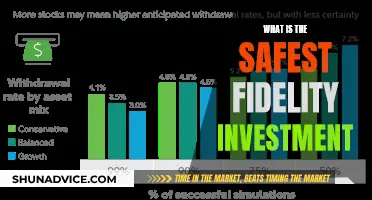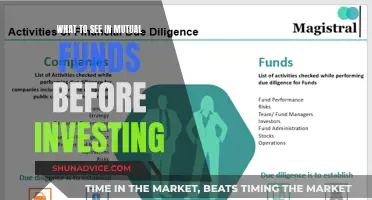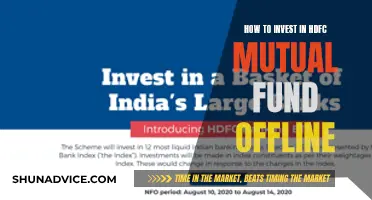
Mutual funds are a popular investment tool for those seeking to beat the market or access a wide range of investments. They are a type of investment product where the funds of many investors are pooled into a single product, which is then used to invest in a group of assets. Mutual funds are safer than picking stocks, and they allow investors to buy a diversified collection of assets in just one fund, often at a low cost. There are thousands of funds to choose from, and they can be bought through a broker or the fund itself. Before investing, it is important to identify your goals and risk tolerance, and to research the fund's past performance and fees.
| Characteristics | Values |
|---|---|
| Type of investment product | Pooling of investors' funds to invest in a group of assets to reach fund's investment goals |
| Investment goals | Long-term capital gains, current income, college expenses, retirement |
| Risk tolerance | High, medium, low |
| Investment horizon | Short, medium, long-term |
| Investment alternatives | Exchange-traded funds (ETFs), individual stocks |
| Management style | Active, passive |
| Management fees | Sales fee/load, management expense ratio, 12b-1 fees |
| Performance | Historical, current |
What You'll Learn

Mutual funds vs. individual stocks
When deciding how to allocate your equity, you can either invest in individual stocks or mutual funds. Both options have their own advantages and disadvantages, and it is important to understand the differences between the two before making a decision.
Mutual Funds
Mutual funds are a type of investment product where the funds of many investors are pooled into an investment product. The fund then uses those assets to invest in a group of assets to reach the fund's investment goals. There are many different types of mutual funds available, and they are often safer and less complicated than individual stocks.
Pros of Mutual Funds
- Risk is spread out by investing in multiple companies as part of a diversified investment fund.
- Financial professionals choose which stocks go into the fund and manage it, so you don't have to closely monitor individual stocks.
- If an individual stock loses value, other stocks in the mutual fund help to balance it out.
- You can invest in a specific industry sector without having to individually choose stocks.
- Many mutual funds, especially passively managed index funds, can be low cost.
Cons of Mutual Funds
- If a single stock excels, you miss out on some of that high growth.
- Some people might prefer greater control over their investments and may not like giving away the choice of stocks to a mutual fund manager.
- Some funds have minimum investment rules and require the fund to be held for a certain amount of time.
- Some funds charge a high expense ratio, sometimes above 1% of your investment in the fund annually.
- May not be tax-efficient — if the mutual fund has sold assets and seen a gain, you might be subject to capital gains taxes.
- Could underperform the market — if you have an actively managed mutual fund, it might not perform as well as the market and you could even lose money.
Individual Stocks
Individual stocks represent shares of ownership in a specific company, and their value fluctuates based on the company's performance and market conditions.
Pros of Individual Stocks
- You control what stocks you invest in.
- If a stock soars, you'll get all the benefit from that increase.
- People might find it exciting and rewarding to pick and follow specific stocks.
- Easy to trade — individual stocks are easy to trade through an online broker, and there are a number of apps that make the process intuitive.
- Low trading costs — in many cases, stocks come with low trading costs, and some brokerages don't charge trading fees for individual stocks.
Cons of Individual Stocks
- Stocks offer higher returns but come with higher risk and volatility.
- Potential for large losses — while there is the potential for large gains, you could also end up with large losses if the stock price drops and doesn’t recover.
- Researching stocks and choosing the right assets for your portfolio can be time-consuming.
- Investing in stocks can be stressful — it’s important to understand your own risk tolerance before you start investing.
- You could be charged a brokerage fee every time you buy or sell an individual stock.
The choice between mutual funds and individual stocks depends on an investor's goals, time horizon, and risk tolerance. Mutual funds are generally a good option for those who want to participate in the stock market but don't want to pick and follow specific stocks, while individual stocks are better for those who want more control over their investments and are willing to take on more risk.
Mutual Fund Lump Sum Investments: Where to Begin?
You may want to see also

Mutual funds vs. ETFs
Mutual funds and exchange-traded funds (ETFs) are two popular investment options for investors looking to diversify their portfolios. While both have their advantages and similarities, there are some key differences to consider when deciding which is the better option for you.
Similarities
Both mutual funds and ETFs are professionally managed collections or "baskets" of individual stocks or bonds. They are both less risky than investing in individual stocks and bonds due to their built-in diversification. They also both give investors access to a wide variety of U.S. and international stocks and bonds.
Differences
Management
Mutual funds are typically actively managed, meaning fund managers follow an investment strategy to buy and sell securities in an attempt to beat the market. ETFs, on the other hand, are usually passively managed, meaning they are pegged to the performance of a particular index.
Trading
ETFs trade like stocks and are bought and sold on a stock exchange, with prices changing throughout the day. Mutual funds, on the other hand, are traded only once per day, with all investors receiving the same price.
Minimum Investment
ETFs do not require a minimum initial investment and are purchased as whole shares. Mutual funds, on the other hand, usually have a flat dollar amount as their minimum initial investment, which is not based on the fund's share price.
Tax Efficiency
ETFs tend to be more tax-efficient than mutual funds as they may have lower turnover and can use the in-kind creation/redemption process to manage the cost basis of their holdings. A sale of securities within a mutual fund may trigger capital gains for shareholders, even if they have an unrealised loss on the overall investment.
Control
ETFs provide real-time pricing and allow for more sophisticated order types, giving investors more control over the price of their trade. Mutual funds are a better option for those who want to keep things simple, as they provide the same price for all investors, regardless of the time of day the order is placed.
Automatic Transactions
ETFs do not allow for automatic investments or withdrawals, whereas mutual funds do.
Index Funds
Most ETFs are index funds (passive investments), whereas mutual funds can be either active or indexed, with most being actively managed.
When deciding between mutual funds and ETFs, it is important to consider your investment goals and your risk tolerance. If you are looking for a fund that could potentially beat the market, an actively managed mutual fund may be the better option. If you are looking for a more tax-efficient option with more control over the price of your trade, an ETF may be more suitable.
Arbitrage Funds: Strategic Investment Opportunities for Savvy Investors
You may want to see also

Actively managed funds vs. passive funds
When it comes to investing, there are two main types of funds: actively managed funds and passive funds. But what's the difference between the two, and which is the better option?
Actively Managed Funds
Actively managed funds are those in which a manager or management team makes decisions about how to invest the fund's money. The goal of active fund managers is to outperform a designated benchmark, such as the S&P 500, while also managing risk, limiting tax consequences, or adhering to specific investing standards. Active fund managers may rely on investment analysis, research, forecasts, and their own judgment and experience when deciding which assets to buy and sell.
The advantage of actively managed funds is the potential to beat the market index and generate higher returns. However, this comes at a cost. Actively managed funds typically charge higher fees, and many fail to beat the market consistently. Additionally, the frequent buying and selling of stocks by active managers result in taxable capital gains for fund shareholders.
Passive Funds
On the other hand, passive funds simply follow a market index and do not have a management team making investment decisions. Instead, they aim to replicate the performance of a particular market index. For example, a stock index fund might track the performance of the S&P 500, a collection of America's top companies. Passive funds are often referred to as "index funds".
The main benefit of passive funds is their lower cost. They tend to have lower fees than actively managed funds, as there is less active management involved. Additionally, passive funds perform more consistently and are considered less risky since they mirror the overall market performance.
The debate between actively managed funds and passive funds is ongoing, and there is no consensus on which strategy yields better results. Ultimately, the decision to invest in actively managed or passive funds depends on an individual's financial circumstances, goals, and risk tolerance. While actively managed funds offer the potential for higher returns, they also come with higher fees and the risk of underperforming the market. On the other hand, passive funds provide consistent performance at a lower cost but may not offer the same opportunity for outperformance.
Best Banks for Mutual Fund Investments in Pakistan
You may want to see also

Mutual fund fees
Annual fund operating expenses
Annual fund operating expenses are ongoing fees charged to cover the cost of paying fund managers, accountants, legal fees, marketing, and so on. These fees are also known as mutual fund expense ratios or advisory fees, and they typically range from 0.25% to 1% of your investment in the fund per year. Actively managed funds, which aim to beat average stock market returns, usually have higher annual fund operating expenses than passively managed funds such as index funds, which only mirror the returns of a benchmark stock index.
The ongoing costs of a fund can be found in its prospectus under "total annual operating expenses" and may include:
- Management fees: The cost of paying fund managers and investment advisors.
- 12b-1 fees: Fees capped at 1% used for marketing and selling the fund and other shareholder services.
- Other expenses: Custodial, legal, accounting, transfer agent expenses, and other administrative costs.
Shareholder fees
Shareholder fees are sales commissions and other one-time costs incurred when buying or selling mutual fund shares. These fees are outlined in the fund's prospectus under the heading "Shareholder Fees" and may include:
- Sales loads: Commissions paid when buying or selling mutual fund shares, also known as front-end or back-end loads depending on when they are charged.
- Redemption fee: Charged when an investor sells their shares within a specified time frame after purchasing them.
- Exchange fee: Charged by some funds when shareholders transfer their shares to another fund within the same fund group.
- Account fee: Charged for maintaining an investor's account, often applied when the account balance falls below a certain amount.
- Purchase fee: Charged to the fund at the time of purchase, distinct from a front-end sales load which is paid to the broker for selling the fund.
It's important to carefully review the prospectus of a mutual fund to understand all the applicable fees and how they may impact your investment returns over time.
Selling Investment Funds: Knowing When to Let Go
You may want to see also

Mutual fund diversification
- Building a Portfolio: The first step towards diversification is building a portfolio that includes various investment instruments such as stocks, bonds, cash mutual funds, and more.
- Sorting Risk Levels: The second step is to sort the risk element of different investment schemes. This can be done by selecting securities with diverse risk levels. That way, even if there is a loss in one area, gains in others can compensate.
- Industry Diversification: Diversification can also be applied across different industries to minimise industry-specific risks.
- Fund Manager's Role: The success of a diversified portfolio depends on the skills of the fund manager, who decides when and where to invest.
- Reducing Exposure: Diversification helps reduce exposure to any one particular investment or index. For example, exchange-traded funds can lower the exposure of a portfolio to a certain index.
- International Investment: Diversification encourages investors to look beyond their domestic market and explore international investment options, thereby opening up a huge avenue for global investment.
- Consistent Returns: By minimising overall risk, diversification helps investors achieve consistent returns and ensures a smoother performance of their portfolio.
It is important to note that diversification does not completely eliminate risks but rather minimises the impact of potential losses. Additionally, while mutual funds themselves offer a degree of diversification, investors usually need more than one fund to create a truly diversified portfolio.
Actively Managed Funds: Where to Invest Your Money?
You may want to see also
Frequently asked questions
A Registered Investment Advisor (RIA) selects the funds, spanning the risk spectrum from conservative to aggressive. Funds are reviewed quarterly and adjustments are made based on investment policy criteria.
A prospectus is a formal legal document that provides details about an investment offering for sale to the public. It contains the facts that an investor needs to make an informed investment decision.
Sign in to your account, navigate to your fund list, and click on the fund you want the prospectus for.
You can use the information in each fund's prospectus, or your financial advisor can help you decide which funds are right for you.
Investment funds come in various forms, including open-ended funds (mutual funds), closed-ended funds, exchange-traded funds (ETFs), and hedge funds.







